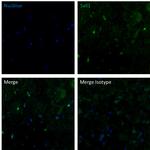Search Thermo Fisher Scientific
FIGURE: 1 / 2
Sall1 Antibody (14-9729-82) in IHC (F)


Product Details
14-9729-82
Species Reactivity
Host/Isotype
Class
Type
Clone
Immunogen
Conjugate
Form
Concentration
Purification
Storage buffer
Contains
Storage conditions
Shipping conditions
RRID
Product Specific Information
Description: This NRNSTNX monoclonal antibody recognizes mouse Sall1. This clone has been reported to be successfully used in flow cytometry, native gel electrophoresis followed by western blot and immunohistochemistry of frozen tissue.
Applications Reported: This NRNSTNX antibody has been reported for use in native gel electrophoresis followed by western blot and in immunohistochemical staining.
Applications Tested: This NRNSTNX antibody has been tested by western blot (native) of mouse brain. This may be used at less than or equal to 5 µg/mL. This clone is not recommended for detection of denatured Sall1.
Applications Tested: This NRNSTNX antibody has been tested by immunohistochemical staining of acetone fixed frozen sections from mouse brain. This may be used at less than or equal to 1.25 µg/mL.
(Fluorochrome-conjugated NRNSTNX is recommended for use in flow cytometry)
Target Information
Sall1, which encodes a zinc finger protein, functions as a transcriptional repressor and interacts physically with histone deacetylase and other components of the chromatin remodeling NuRD complex. It is unknown whether the transcriptional repression is solely dependent on histone deacetylase activity. Gene expression profiling has identified Sall1 as a microglial signature gene. Microglia are the resident macrophages of the central nervous system (CNS). Sall1 is also expressed in abundance in the mesenchyme-derived structure from condensed mesenchyme, S-comma-shaped bodies, to renal tubules and podocytes. Sall1 has been identified as a key transcription factor in self-renewal renal progenitor cells. Sall1 is required to maintain the stemness of nephron progenitor cells by restraining their differentiation into renal vesicles. Defects in SALL1 are the cause of Townes-Brocks syndrome as well as bronchio-oto-renal syndrome. Heterozygous mutations of human SALL1 leading to Townes-Brocks syndrome features dysplastic ears, preaxial polydactyly, imperforate anus, and less commonly, kidney and heart anomalies (Kohlhase et al. 1998). Two transcript variants encoding different isoforms have been found for this gene.
For Research Use Only. Not for use in diagnostic procedures. Not for resale without express authorization.
References (0)
Bioinformatics
Protein Aliases: sal-3; sal-like protein 1; zinc finger protein Spalt-3
Gene Aliases: Msal-3
Entrez Gene ID: (Mouse) 58198

Performance Guarantee
If an Invitrogen™ antibody doesn't perform as described on our website or datasheet,we'll replace the product at no cost to you, or provide you with a credit for a future purchase.*
Learn more
We're here to help
Get expert recommendations for common problems or connect directly with an on staff expert for technical assistance related to applications, equipment and general product use.
Contact tech support
